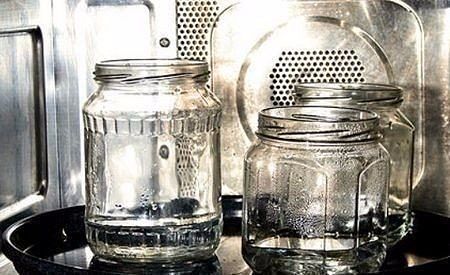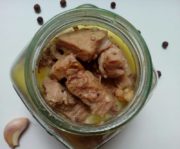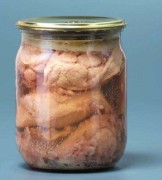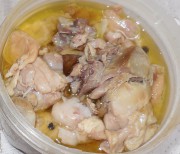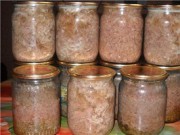Homemade canned meat - technology and preparation of meat stew at home.
Many housewives wonder how to properly prepare meat for the winter or for future use, for long-term storage. A good option for such preservation is canned meat prepared at home. Homemade stew, prepared from fresh meat by the caring hands of the housewife, is undoubtedly healthy and tasty, as it does not contain preservatives.
But, in addition to beneficial properties and excellent taste, homemade meat preparations can also be fraught with danger to the human body. In this article, I propose to study the rules for preparing and subsequently storing homemade stew, and also find out how canned meat prepared for future use without following the necessary technology can be dangerous to the body.
Content
- 1 What could be the harm of stewed meat or what are the dangers of home-canned meat?
- 2 How to choose and prepare containers for canned meat
- 3 How to properly place meat in prepared jars
- 4 How to hermetically seal containers with canned meat
- 5 How to properly sterilize jars of stewed meat
- 6 How to properly cool jars of stewed meat after sterilization
- 7 How to store homemade meat stew
What could be the harm of stewed meat or what are the dangers of home-canned meat?
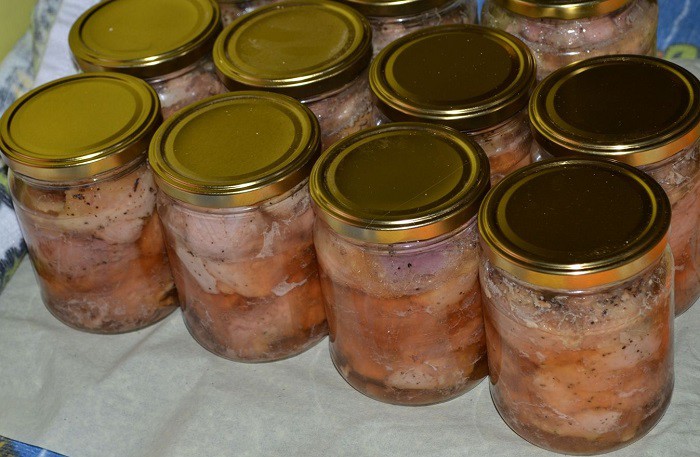
You can preserve the meat of any animal, but it is imperative that it be exclusively fresh.Even if you strictly follow the technology for preparing and storing stewed meat, due to stale raw materials, rotting bacteria can develop that are harmful to the human body.
Also, it should be taken into account that when canning at home in jars with the preparation, due to the lack of oxygen, a favorable environment for the development of anaerobic bacteria can be formed. The most dangerous of which for the human body is the causative agent of botulism - botulinum toxin. If this toxin enters the human gastrointestinal tract, quite serious consequences can occur, ranging from severe poisoning to death.
How to choose and prepare containers for canned meat
Very often, housewives use used glass containers to pack meat when preparing homemade stew. Simply these are jars from last year’s homemade preparations.
Therefore, in order to prevent various bacteria from entering our homemade preparations in the future, it is necessary to thoroughly wash the empty glass containers in hot water with special care before storing them until the next harvesting season.
We should also do the same with used cans of stewed meat. First, we clean them of food debris and rinse them with running hot water. Then, you need to place the jars so that water drains from them. And only dry jars can be safely removed for storage.
Before making new blanks, the jars must be washed again with detergent or soda, rinsed in running hot water and sterilized over steam or in another way that suits you.
The most convenient for packaging stewed meat are, of course, half-liter jars.But you can cook canned meat in a liter container. But in two-liter glass jars, I would recommend preparing homemade sausage for the winter or preserving smoked meats, but not stew.
How to properly place meat in prepared jars
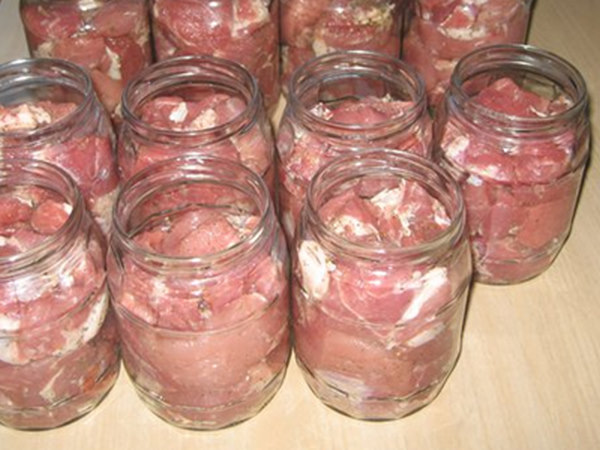
After the container for preparing the stew is prepared, we can begin packaging the meat. Depending on the recipe, home canned food is made either from raw meat or from a semi-finished product that has already undergone heat treatment. Stewed, baked, fried meat must be packaged hot in jars.
We need to fill the jars with meat and gravy “up to the shoulders,” that is, two centimeters below the neck of the jar. Make sure that the contents do not fall out or stick out of the jar under any circumstances. Keep in mind that during the sterilization process, the tendons and cartilage joints in the meat increase in volume and the lids may break off in overfilled jars. Thus, the contents will leak out of the cans and our preparation will be spoiled.
How to hermetically seal containers with canned meat

In order to preserve homemade meat stew for a long time, it is important not only to fill the container correctly and sterilize it. The quality of the stewed meat also depends on how carefully we sealed the jar. After all, if the lid does not fit tightly enough to the neck of the jar, then during sterilization air or water may get in there and the canned food will be unfit for consumption.
It is very easy to check whether the jars are securely sealed. To do this, you need to place them in a container of hot water, and then bring the water to a boil.If the jar is not properly sealed in boiling water, you will see air bubbles coming out of the jar.
Glass lids equipped with auxiliary metal clips are considered the most suitable for sealing jars of homemade stew. During the sterilization process, air leaves the jars and thus a vacuum is formed between the lid and the contents of the container.
As the jars cool, the volume of their contents decreases, as a result of which the external pressure on the lid increases, and it fits more tightly to the neck of the jar.
How to properly sterilize jars of stewed meat
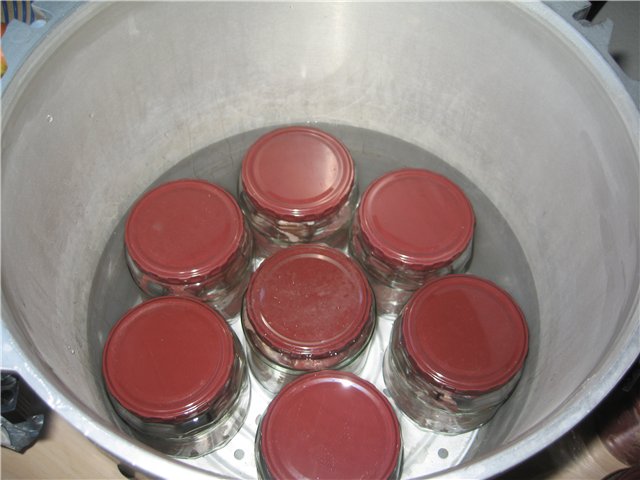
We need to place hermetically sealed jars of homemade preserves in a container of suitable size. Then we fill them with water and sterilize them at a temperature of at least 100°C.
The most suitable temperature for sterilizing meat products is from 115 to 120 °C. It is at this temperature that botulinum bacteria die.
But how can we achieve such a temperature by sterilizing jars in ordinary containers? It turns out there is a way out. An ordinary pressure cooker can be used as an autoclave when preparing homemade preserves. In such a device, we can easily reach the temperature required for sterilization, and the process of heat treatment of homemade stew will take no more than an hour and a half (depending on the type of meat and its processing method).
But even if you don’t have a pressure cooker in your arsenal, you shouldn’t be upset. To sterilize canned meat at a temperature of 100°C, any container can be used. Some housewives have adapted to sterilize canned food in tanks for boiling laundry. If the batch of canned food is large enough, try sterilizing it in an enameled or copper cauldron.
We need to place cans of canned meat in cool or slightly warmed (20-30°C) water, and then bring the water to a boil. After the water boils, we need to sterilize the stew for the amount of time required by the recipe.
If you used raw meat to prepare the canned food, or if you plan to store this product for more than six months, the homemade stew must be re-sterilized.
We need to do this procedure 48 hours after the first sterilization. In this case, cans of canned food can be stored at room temperature (from 20 to 30°C) before repeating the procedure. We can carry out repeated sterilization 90 days after the initial one, but provided that the cans of canned food are stored at a temperature not exceeding 10°C.
We need to carry out repeated sterilization, just like the first one, at a temperature not lower than 100°C. But the duration of this procedure can be reduced by a quarter of the initial time of heat treatment of canned meat.
How to properly cool jars of stewed meat after sterilization

Cans of home-canned meat can be cooled in two ways: either in the open air or using cold water.
If you plan to cool cans of meat products using water, be careful. Since the contents of the cans are hot after prolonged heat treatment, the cans of stew may burst due to the temperature difference. To prevent this from happening, add cold water to the container with the jars in small portions. When cooling in this way, try not to let the stream of water fall directly on the hot cans.
But my advice is to let the jars of your best and most delicious homemade stew cool naturally.It is best to simply leave cans of canned meat to air cool. When cooled in this way, the contents of the jars retain a high temperature for a long time. Therefore, you can sterilize such homemade preparations a quarter of an hour less than the time specified in the recipe.
After the jars have completely cooled, we definitely need to once again make sure that the container is hermetically sealed and that there is no damage to the lid itself.
If during such a check you find a jar with a loose lid, then after eliminating the cause, such canned food must be subjected to a repeated heat treatment (sterilization) process. Or, I advise you to immediately consume the contents of the jar as food (before bacterial damage occurs).
How to store homemade meat stew
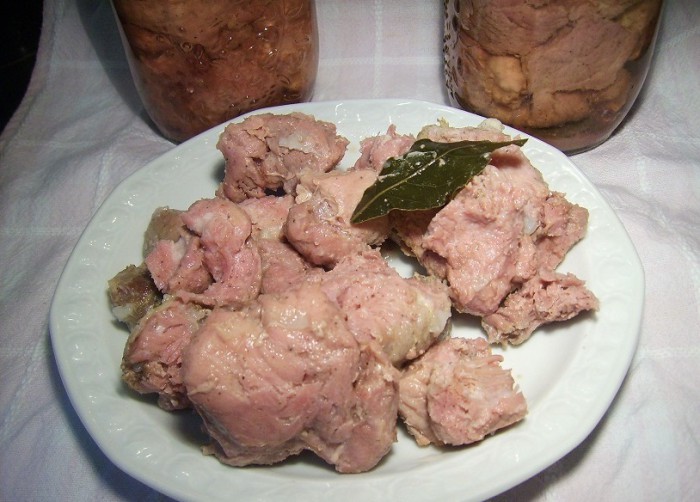
We need to place cans of canned meat that have been tested for tight seals in a cool room for storage. The optimal storage temperature for our homemade meat preparations is from 10 to 15°C. With the correct storage temperature, the risk of canned food being damaged by botulinum toxin bacteria is reduced to zero.
If during the warm season the temperature in the room you use to store homemade preparations rises, then you need to check the cans of stewed meat several times a week. If during such an “audit” you find damaged (swollen, cloudy) cans, dispose of them immediately. It is strictly forbidden to eat such stew!
After reading my simple recommendations for preparing meat at home for future use, feel free to select the recipe you like and start cooking stew at home.


